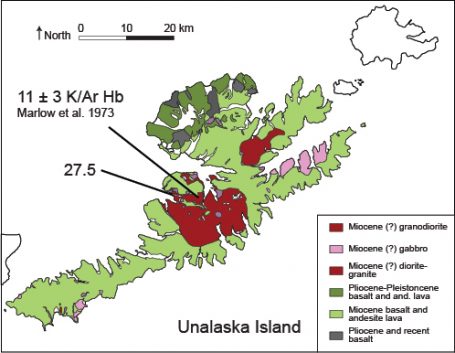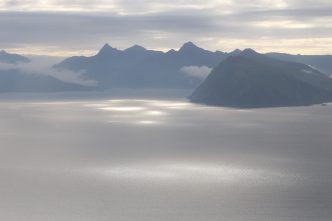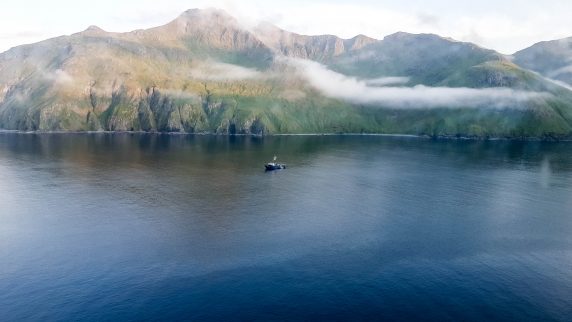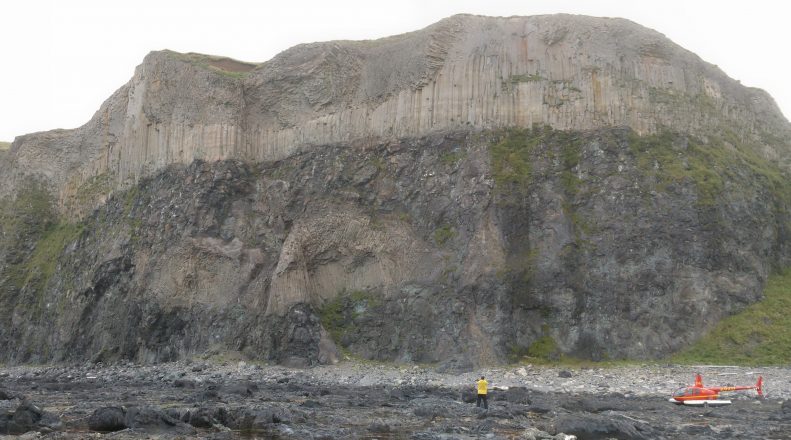Peter Kelemen (Columbia University, LDEO) on behalf of Merry Yue Cai (Columbia University, LDEO), Emily H.G. Cooperdock (UT Austin), Steve Goldstein (Columbia University, LDEO), Matt Rioux (UC Santa Barbara), and Gene Yogodzinski (University of South Carolina)
Benefiting from the NSF GeoPRISMS community platform in the Aleutian volcanic arc in the summer of 2015, our group from the University of South Carolina and Columbia University had a
matchless opportunity to study and sample outcrops of pre-Holocene volcanic and plutonic rocks on Unalaska, Umnak, and Atka Islands. Speaking for myself, at the age of 59 and having worked in the field in a lot of spectacular places – every year for forty years – this was one of the most memorable and rewarding field seasons of my life.
The older rocks in the Aleutian volcanic arc are notable because they include the most extensive outcrops of plutonic rocks in any oceanic arc, worldwide. Aside from the visionary work of Sue and Bob Kay and their colleagues, these plutonic rocks have not received much attention since pioneering USGS studies were completed in the 1950’s (Umnak), 1960’s (Unalaska), and 1970’s (Atka). This prior work demonstrated that the Eocene to Miocene plutonic rocks east of Adak Island were more strongly “calc-alkaline”, with higher SiO2 at a given Mg/Fe ratio, compared to the “tholeiitic”, Holocene volcanic rocks on the same islands.
In a recently published pilot study using USGS samples (Cai et al., Earth Planet. Sci. Lett. 2015), we found that these plutonic rocks are also isotopically distinct from the lavas on the same islands, demonstrating that the two suites were generated by melting of two distinct sources.
Our field season in the summer of 2015 was designed to investigate whether these differences in source composition were the result of :
- temporal evolution of the arc, in which case Miocene to Eocene lavas should have isotope ratios similar to those of calc-alkaline plutons, and perhaps will also mirror the calc-alkaline compositions of these plutons, or
- distinct processes, in which viscous, SiO2– and H2O-rich, calc-alkaline, andesitic magmas tended to stall and form mid-crustal plutons, while relatively low viscosity, SiO2– and H2O-poor, tholeiitic, basaltic magmas tended to erupt on the surface, in which case Miocene to Eocene lavas may be isotopically (and compositionally?) distinct from coeval plutons.
To this end, we hoped to sample coeval plutonic and volcanic arcs on several Aleutian islands where the plutons are well-exposed.
Our starting plan was to set up fly camps in the alpine terrain on the islands, which is underlain by extensive outcrops of granodiorite and diorite plutons. We assumed that we would have difficulty obtaining ages on highly altered volcanic rocks, whereas it would be relatively easy to date zircons from the large plutons. Thus, we expected to sample volcanic rocks where they are intruded by plutons of known age. Frankly, my expectations about the field work were not high. I imagined we would be semi-lost in perennial fog, while disconsolately scraping moss, lichen, and tundra grasses off texture-less, fine-grained, grey-green outcrops, and spending a lot of time arguing about whether a specific sample was volcanic, plutonic, or even sedimentary!
Merry Cai, Steve Goldstein, Gene Yogodzinski, and I flew to the commercial airport in Dutch Harbor on Unalaska Island on August 5, where we were joined by pilot Sean Charlton in Pollux Aviation’s R44 helicopter. Sean had flown out from the mainland, with floats fully inflated. I had never used such a small, gasoline-powered helicopter, with an engine not much larger than a lawnmower, so I was a bit skeptical at first. We initially focused on the Shaler pluton on Unalaska, which is the largest in the Aleutians, and hence in any oceanic volcanic arc, worldwide. The weather was quite good when we were there, which allowed us to fly every day. Everyone says the Aleutian weather is bad and unpredictable, and of course, it is, but not always. Working there can often be quite nice. We set up a couple of fly camps, and ranged through the beautiful alpine terrain, examining complex border facies of granodiorite, diorite and volcanic hornfels. We also took advantage of the helicopter on re-supply days to make ground stops along the coast. There, we found exceptional outcrops, including surprisingly fresh volcanic rocks with chilled margins, suitable for 40Ar/39Ar geochronology.
After a while, the exceptional coastal exposures, coupled with the convenience of the helicopter, induced a change in our plans. We moved into the hotel in Dutch Harbor, and flew every day. It
turned out that world-class sea cliff outcrops, coupled with wave cut terraces that offered ideal helicopter landing sites at all but the highest tides, provided a spectacular opportunity for us to conduct comprehensive sampling.
As the photos accompanying this article show, the Aleutian sea cliffs revealed spectacular sequences of pillow lavas, pyroclastic deposits, and columnar-jointed sills. Indeed, photos in the USGS Bulletins showed some of these exceptionally well-exposed features, but in earlier years, without a helicopter, these outcrops were very difficult to access from small boats. In addition, there were few opportunities to obtain reliable ages on the lavas. With the helicopter, and some confidence about 40Ar/39Ar dating of fine-grained volcanic rocks, we were in heaven. Further, as it turns out, our samples from the many sills intruding the volcanics will provide plenty of opportunities to check the Argon ages using U/Pb in zircon.
As it turned out, the R44 helicopter was perfect for us, fitting easily into small landing spots, often within ten meters of the Pacific surf. Unfortunately, Steve Goldstein came down with shingles and had to convalesce in Dutch Harbor, sampling volcanic rocks from the extensive road network when he could. However – sorry Steve! – this did reduce our helicopter-supported group to three, who just fit into the three passenger seats in the R44, enabling ultra-efficient field work. We would leapfrog along the coast, setting out one or two people at each landing spot, and scheduling pickups a few hundred meters further along the coast.
In the middle of August, we moved from Unalaska to Umnak Island, where we were fortunate to stay in a bunkhouse at Bering Pacific Ranches, Ltd., near the abandoned WWII airfield at Fort Glenn. This is a fascinating operation; while we were there, Ranch owner Pat Harvie and his crew were preparing to round up thousands of “organic, free-range” cattle from across the island, using a fleet of R22 helicopters, plus a lot of bailing wire and duct tape. These animals were destined for shipment to Canadian markets in the late summer and early fall. We all hope this visionary operation ended in great success!
From this spectacular basecamp, we spent several productive days sampling along the north and southeast coasts of the island, with a side-trip to the rim of the giant Okmok caldera during a clear spell. We also used the opportunity to access the westernmost peninsula of Unalaska Island, completing our extensive sampling there. All too soon, it was time to leave the Ranch. We returned to Dutch Harbor, where we met Captain George Rains, the crew of the R/V Maritime Maid, and pilot Dan Leary with Maritime Helicopters’ Bell 206 Long Ranger. We also rejoined a rejuvenated Steve Goldstein, together with his daughter, Emily Cooperdock, who had flown up to join us. This increase in our group size corresponded with the change from the four-seat R44 to the six-seat 206, and as a result we remained a highly efficient, helicopter-supported team!
We moved into comfortable quarters onboard the Maid and, delayed by weather, spent a few more days living on the ship in Dutch Harbor, continuing to sample on Unalaska Island. Until this point, we had not lost a single day to weather, though we had gotten wet on a couple of days.
However, our transit to Atka Island, and our work there, were substantially delayed by wind, then fog. A side benefit was a spectacular morning at anchor among the Islands of Four Mountains,
where we photographed the perfect strato-volcanoes there while we waited for the helicopter to catch up with the ship. Finally, the weather cleared and we spent a highly productive day and a half
racing along the western peninsula of Atka Island, acquiring a fantastic set of samples, including previously dated intrusions that span the range from the youngest (9 Ma) to oldest (39 Ma) plutons known in the arc east of Adak.
We then set out for Adak Island. In the airport there, we greeted the next group who would use the GeoPRISMS community platform onboard the Maid, led by Liz Cottrell. We wished them all the best and, sadly, began the long trip home.
In addition to the pilots, and the crew of the Maritime Maid, we would like to express deep gratitude to Program Manager Jenn Wade at NSF, who worked tirelessly to make the community platform concept come alive, and to Christie Haupert, Alaska Science Project Manager for Polar Field Services, Inc., who provided flawless logistical support.
PS: Since that time, we’ve been working hard processing our samples and obtaining initial data. On the left is a plot of some early, major element analyses of our samples from Unalaska Island. Note that, as for the USGS samples we analyzed for our pilot study (Cai et al., Earth Planet. Sci. Lett., 2015), most of our 2015 plutonic samples are calc-alkaline and most of our 2015 mafic lava samples are tholeiitic, despite the fact that the 2015 lavas and plutons are approximately coeval. This suggests that the chemical differences documented by Cai et al. (2015) are present among coeval igneous rock suites in the Aleutians, and did not arise as a result of temporal evolution of both volcanic and plutonic magmatism.
In addition to our main line of inquiry, outlined above, we are evaluating the potential for study of detrital zircons in volcanoclastic sediments, while Emily Cooperdock is preparing a proposal to study the uplift and denudation history of the Aleutians via U-Th-He thermochronology as well as fission track and 40Ar/39Ar analyses. ■


A) Schematic map of the Aleutian island arc, sampled areas are highlighted in black. B) Wt% SiO2 versus Fe/Mg ratio of studied Aleutian igneous rocks. By convention, the Fe/Mg ratio is calculated using wt% MgO and FeO, with all Fe as FeO. C) Present-day Nd and Pb isotope ratios of Aleutian igneous rocks vs. longitude and vs. age. Circles are central and eastern Aleutian volcanics: Yellow = Rat and Delarof Islands, Green = Adak and Kanaga, Blue = Atka, Purple = Umnak, White = Unalaska. Error bars are smaller than the symbols. In 3) and 4), the Holocene volcanics are separated by location only without age differences. Figures from Cai et al., Earth Planet Sci. Lett. 2015.
“Report from the Field” was designed to inform the community of real-time, exciting GeoPRISMS -related research. Through this report, the authors expose the excitement, trials, and opportunities to conduct fieldwork, as well as the challenges they may have experienced by deploying research activities in unique geological settings. If you would like to contribute to this series and share your experience on the field, please contact the GeoPRISMS Office at info@geoprisms.nineplanetsllc.com. This opportunity is open to anyone engaged in GeoPRISMS research, from senior researchers to undergraduate students.
We hope to hear from you!







